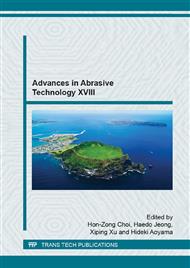[1]
H. Wu, C. Yang, S.N. Melkote, Effect of reciprocating wire slurry sawing on surface quality and mechanical strength of as-cut solar silicon wafers, Precis. Eng. 38 (2014) 121-126.
DOI: 10.1016/j.precisioneng.2013.08.003
Google Scholar
[2]
D.C. Canizo, D.G. Coso, W.C. Sinke, Crystalline silicon solar module technology: Towards the 1 &euro per watt-peak goal, Prog. Photovoltaics Res. Appl. 17 (2009) 199-209.
DOI: 10.1002/pip.878
Google Scholar
[3]
H. Wu, S.N. Melkote, Study of ductile-to-brittle transition in single grit diamond scribing of silicon: application to wire sawing of silicon wafers, J. Eng. Mater. Technol. Trans. ASME 134 (2012) 41011.
DOI: 10.1115/1.4006177
Google Scholar
[4]
S.H. Lee, Analysis of ductile mode and brittle transition of AFM nanomachining of silicon, Int. J. Mach. Tools Manuf. 61 (2012) 71-79.
DOI: 10.1016/j.ijmachtools.2012.05.011
Google Scholar
[5]
Z.Y. Zhang, C.G. Xu, X.Z. Zhang, D.M. Guo, Mechanical characteristics of nanocrystalline layers containing nanotwins induced by nanogrinding of soft-brittle CdZnTe single crystals, Scripta Mater. 67 (2012) 392-395.
DOI: 10.1016/j.scriptamat.2012.05.033
Google Scholar
[6]
Z.Y. Zhang, Y.X. Huo, D.M. Guo, A model for nanogrinding based on direct evidence of ground chips of silicon wafers, Sci. China Technol. Sci. 56 (2013) 2099-2108.
DOI: 10.1007/s11431-013-5286-2
Google Scholar
[7]
X.N. Jing, S. Maiti, G. Subhash, A new analytical model for estimation of scratch-induced damage in brittle solids, J. Am. Ceram. Soc. 90 (2007) 885-892.
DOI: 10.1111/j.1551-2916.2006.01471.x
Google Scholar
[8]
F. Ebrahimi, L. Kalwani, Fracture anisotropy in silicon single crystal. Mater, Sci. Eng. A 268 (1999) 116-126.
DOI: 10.1016/s0921-5093(99)00077-5
Google Scholar
[9]
S. Shim, H. Bei, E.P. George, G.M. Pharr, A different type of indentation size effect. Scripta Mater. 59 (2008) 1095-1098.
DOI: 10.1016/j.scriptamat.2008.07.026
Google Scholar
[10]
W.C. Oliver, G.M. Pharr, An improved technique for determining hardness and elastic modulus using load and displacement sensing indentation experiments. J. Mater. Res. 7 (1992) 1564-1583.
DOI: 10.1557/jmr.1992.1564
Google Scholar
[11]
Z.Y. Zhang, C.G. Xu, X.Z. Zhang, D.M. Guo, Mechanical characteristics of nanocrystalline layers containing nanotwins induced by nanogrinding of soft-brittle CdZnTe single crystals. Scripta Mater. 67 (2012) 392-395.
DOI: 10.1016/j.scriptamat.2012.05.033
Google Scholar


